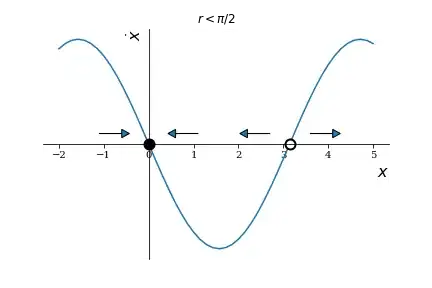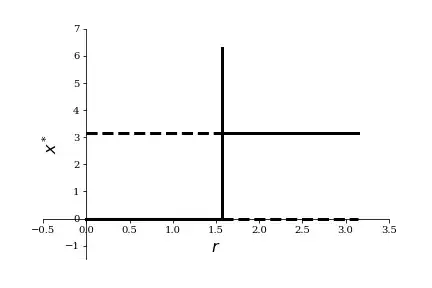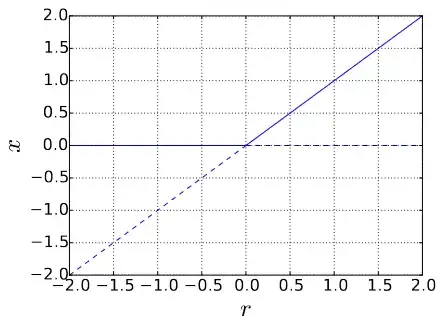TL;DR: I don't believe the system displays a transcritical bifurcation.
Your stability analysis is correct. For instance, for $r=0$, $\dot{x}$ is simply a negative sine function, so positive $x\approx 0$ values have negative derivatives (and decrease, i.e., move towards zero) and negative values have positive derivatives (so increase and also move towards zero), i.e., $x=x^*=0$ is stable for $r<\pi/2$. See figure below:

And the system does go through a bifurcation as $r$ is varied — though not one of the simple ones, due to the singular nature of the system at $r=r^*=\pi/2$: For this value of $r$ all points $x\in[0,2\pi]$ are (neutrally stable) fixed points, since the system is simply $dx/dt=0$. That's how I'd sketch its bifurcation diagram:

It looks like we could say there's a collision on $r^*=\pi/2$ and the fixed points "exchange stabilities — just like in a transcritical bifurcation, however, I think we have something different here, for two reasons:
I. If we check the formal conditions for the system $\dot{x}=f_r(x)$ to go through a transcritical bifurcation (e.g., Guckenheim & Holmes or Wolfram MathWorld), we'll see they are:
\begin{align}
f_r(x)\Bigr|_{\forall r, x=x^*}=0 \tag{equilibria}\\
\frac{\partial f_r}{\partial x}\Bigr|_{r=r^*, x=x^*} = 0 \tag{null eigenvalue}\\
\frac{\partial^2 f_r}{\partial r\partial x}\Bigr|_{r=r^*, x=x^*} \ne 0 \tag{TC1}\\
\frac{\partial^2 f_r}{\partial^2 x}\Bigr|_{r=r^*, x=x^*} \ne 0 \tag{TC2} \label{TC2}
\end{align}
where TC stands for transversality condition. And it's clear that our $f_r(x)$ fails to satisfy \ref{TC2}.
II. By changing variables, $r \mapsto -r + \pi/2$, the system becomes $f_r(x)=-\sin(r)\sin(x)$ and $r^*=0$. If we then try to put $f_r(x)$ in a algebraic normal form, by Taylor expanding it around $(r^*,x^*)$ we obtain, after a new change of variables $r\mapsto r-r^3/6$,
$$
f_r(x) = rx -r\frac{x^3}{6} +O(5)
$$
which I don't believe can be put in the normal form for the transcritical bifurcation, nor any of the other simple ones:
\begin{align}
\dot{x} &= r - x^2 \tag{saddle-node}\\
\dot{x} &= rx - x^2 \tag{transcritical}\\
\dot{x} &= r - x^3 \tag{pitchfork}
\end{align}
Which is perhaps not that surprising, given the system's bifurcation diagram.


